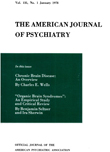DSM-III field trials: II. Initial experience with the multiaxial system
Abstract
The multiaxial system of DSM-III includes nondiagnostic data that are valuable in understanding possible etiological factors and in treatment planning and prognosis. The authors describe the reliability of axis IV- -severity of psychosocial stressors--and axis V--highest level of adaptive functioning in the past year--for 281 adult patients interviewed in phase one of the DSM-III field trials. The kappa coefficient of agreement for axis IV was .62 for joint interviews and .58 for separate interviews, which the authors consider at least fair. Reliability for axis V was quite good, .80 for joint interviews and .69 for separate interviews. Eighty-one percent of the participating clinicians judged the multiaxial system to be a useful addition to traditional diagnostic evaluation, although many indicated that they had difficulty quantifying severity of psychosocial stressors.
Access content
To read the fulltext, please use one of the options below to sign in or purchase access.- Personal login
- Institutional Login
- Sign in via OpenAthens
- Register for access
-
Please login/register if you wish to pair your device and check access availability.
Not a subscriber?
PsychiatryOnline subscription options offer access to the DSM-5 library, books, journals, CME, and patient resources. This all-in-one virtual library provides psychiatrists and mental health professionals with key resources for diagnosis, treatment, research, and professional development.
Need more help? PsychiatryOnline Customer Service may be reached by emailing [email protected] or by calling 800-368-5777 (in the U.S.) or 703-907-7322 (outside the U.S.).



